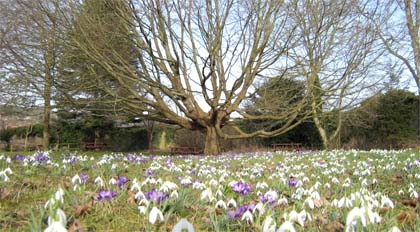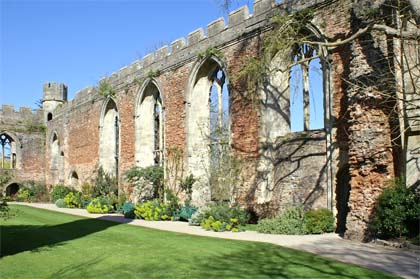

|
Back to |
| The Front Page |
| News & Features |

|
Croquet at the Bishop's Palace is central to this "event" site |
||||||||||
|
by Bob Alman with much help from Nichola Davey, Secretary of the Palace Croquet Club photos from the Bishop's Palace website and Nichola Davey
|
||||||||||
|
||||||||||
Except for having their season officially opened by the Bishop of Bath and Wells, for being surrounded by a moat and fortified against attack, and for having the games witnessed by many of the 100,000 visitors a year to the site, it's exactly like your club, where the sport is played by ladies and gentlemen properly attired. And there are the well pools and the gardens and defensive turrets and a new restaurant, all shown in the photographs provided by Nicky and the official website of the Bishop's Palace.
The Bishop's Palace has been home to the Bishops of Bath and Wells for more than 800 years. It's only in the last century that an interesting activity has been added to lawn within the oval drive that leads to the main entrance after visitors cross the drawbridge over the moat and enter through a gate in the fortified walls.
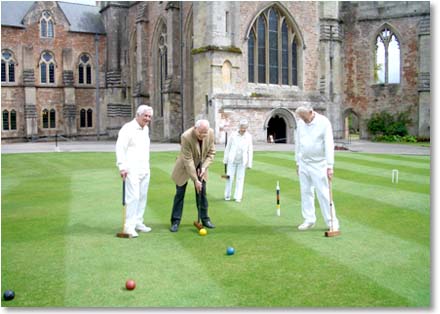
|
| Bishop Peter Price officially opened the season in 2012 by preparing a roquet of yellow upon blue, employing an Irish grip--even though he did not play the game. |
The croquet lawn occupies a very small portion of the 14 acres of the Palace grounds, much of which is devoted to gardens and pools where weddings and other special events are regularly produced. The impressive medieval palace--which you may have seen in location for such films as "The Huntsman: A Winter's War", "The White Princess", "Hot Fuzz" and the TV Series "Poldark"--is the well-preserved centerpiece.
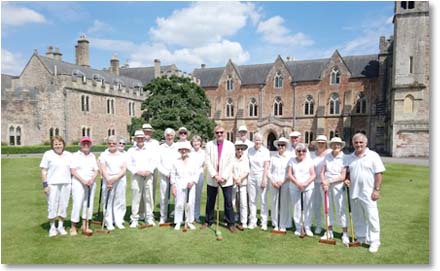
|
| Bishop Peter Hancock opted for a formal pose with the regular club members to open the 2019 season. |
Competitive croquet here was once included as part of the English South West Federation of Croquet Clubs league but since 2008, the club has been primarily devoted to providing a delightful space for members to enjoy playing the game.
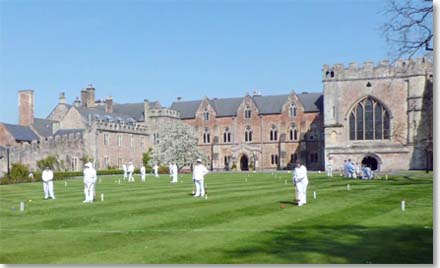
|
| All three reduced-size courts are in play today. The club members know they are playing at the pleasure of the Palace Trust and entertaining tourists simply by playing casual games in their regulation whites. |
Originally most members played traditional Association Croquet but over recent years Golf Croquet seems to be preferred, although recently there has been an influx of Association Croquet players. Some members also play on the more perfect croquet lawns of nearby Nailsea, Camerton and Peasedown clubs.
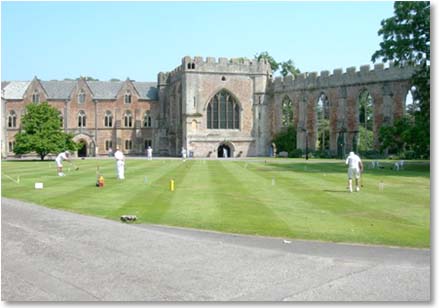
|
| Picnics for the players are centered in the shade of the black walnut tree on the right. |
There are three reduced-size courts in front of the palace, and a blackwalnut tree provides shade for the picnics that contribute to the scene. Players are accustomed to being watched by the many visitors and being photographed.

|
| The windows of the Anglican chapel and the ruins of the Great Hall overlook the courts. |
A new cafe overlooking the croquet lawn gives visitors a chance to watch the game being played. By tradition the Bishop of Bath and Wells--the croquet club's president--opens the season in a formal ceremony reported by the local press. This year Bishop Peter Hancock--who learned to play the sport of croquet at University--found time to play a game on the lawns and stayed to have tea and cake with members.
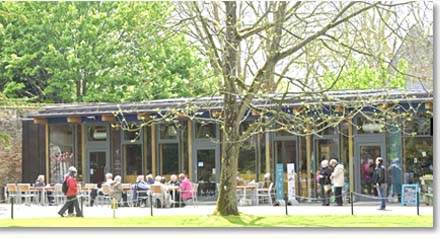
|
| The austerely modern Bishop's Table, overlooking the croquet lawn with a terrace, is a popular site for casual dining and group events. The croquet club gathers here as well. |
How the club operates in the middle of a tourist site
The croquet club, with no likely opportunities for more playing space and membership at an historic high of 42, is not looking to expand, according to Nicky. But leaflets about the game of croquet are available at the Palace shop, and people interested in joining the club can contact Guy Arnoux, the Palace Croquet Club Chairman, to have a "taster" session before joining.
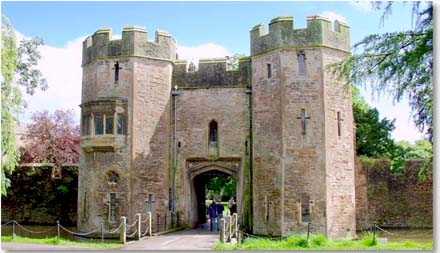
|
| The Bishop by tradition participates with the townspeople in annual boat races in the moat that circles the Palace. When visitors enter they'll see the croquet courts in front of the Palace. Much of the fourteen acres of medieval buildings, gardens, wells, streams, and lakes lie outside the moated and fortified Palace. |
She adds, "Each year a few friendly matches are played against other local clubs, and during the year we normally hold a couple of informal Golf Croquet tournaments in which each round is with a different partner. These are mainly social events that include all members enjoying a picnic together under the big walnut tree."
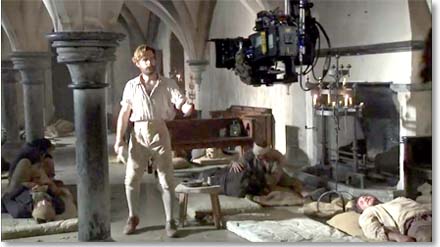
|
| Interiors are used often for television and movies, including Poldark (above). |
During a Three-Day Garden Festival held each summer in the Palace grounds, club members are on the lawn and offer members of the public a chance to "have a go" at croquet.
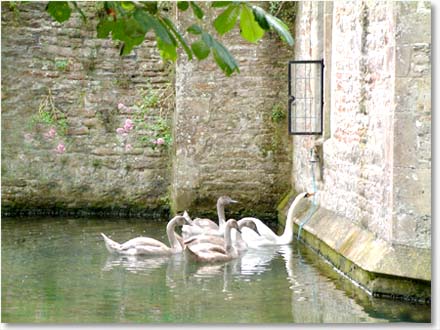
|
| The palace swans that swim in the moat were taught some time ago to ring the gatehouse bell to ask for food. |
The Wells U3A (University of the Third Age) has a group which play on the lawn twice a month. The club hosts about three evenings each season for the local Rotary members and some evenings for members of the Women's Institute.

|
| The Palace, grounds, and associated buildings are not just a tourist attraction, but an important cultural resource for local residents--including many programs for children. The English style of gardening avoids the appearance of arranged formality and encourages a profusion of growth. |
And finally, perhaps in late October, the club members bid farewell for the winter with an End of Season Tea together in the restaurant.
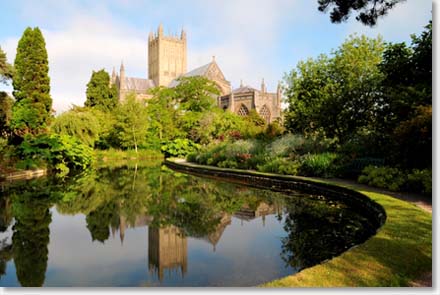
|
| The flowing springs and wells that fill man-made lakes and feed the moat give their name to the City of Wells and constituted for centuries the town's early water supply. |
"Social Croquet" is not a disparagement at the Palace
The main activity of the club are club afternoons when members can just turn up and get a game. With the increase of Golf Croquet members, Monday, Wednesday and Friday afternoons are for Golf Croquet, and Association Croquet can be played on Tuesday and Thursday afternoons. Members may arrange their own games at other times or over the weekend.
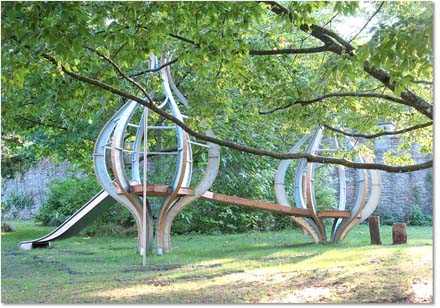
|
| The gardens are designed and managed to serve the local community as well as visitors. The fanciful sculpture and slide here is part of an educational experience for children called "The Dragon's Lair." |
"We do not have a club house," Nicky says, "but we do have a lock up room for our equipment. The lawns are maintained by the Palace gardeners. And of course, we use the restaurant often, ourselves."
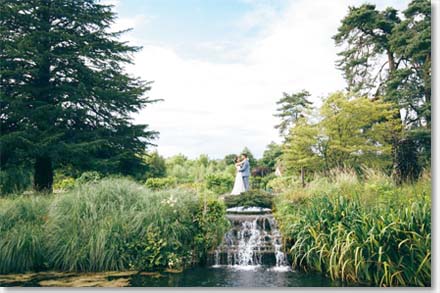
|
| Much like the great houses of England, historic sites of many kinds are encouraged to support themselves in ways that contribute to the community; weddings are a popular part of the mix of events and activities held on the Palace grounds. |
"And where else," Nicky says, "can you spend such a delightful afternoon in more pleasant and beautiful surroundings?"
|
A brief history of the palace and grounds
The first record of a church at this location dates from the 700s. Tradition has it that King Ine gave his scholarly bishop Athelm a grant of land to establish a minster church. The presence of the wells defines the character of this site. It was described as "the minster lying next to the great spring at Wells." The most active of the springs became known as St Andrews Well, sharing the same dedication as the minster. By the 1200s the wells were enclosed as part of the Palace grounds and the bishop had control over the water supply.
The Palace as it appears today reflects the characters and priorities of the bishops. In the early 13th century King John granted the land south of the great cathedral to Bishop Jocelin (the first bishop to hold the title of Bath and Wells) to build a residence. His building survives today as the central part of the present complex.
The chapel was built later that century by Bishop Burnell, who also built the Great Hall in preparation for a visit by King Edward I--which never happened. 300 years later, when King Henry VIII dissolved the monasteries, the Great Hall fell into ruin, and it was not until the 19th century that Bishop Law restored much of the remains to make a romantic setting of its ruins.
In the 14th century the Palace buildings stood on a low island facing St Andrew's Cathedral. A stream separated the two sites, flowing from the wells. Bishop Ralph of Shrewsbury transformed the damp site by channelling the water from the wells into a moat surrounding the Palace. He also built the ramparts with round towers at each corner and a defensive gatehouse. The drawbridge was last raised in 1831, when there were riots in Bristol and concerns that the Bishop in Wells might also be a target. - Nichola Davey |

